Hostess Gifts with a Local Spin
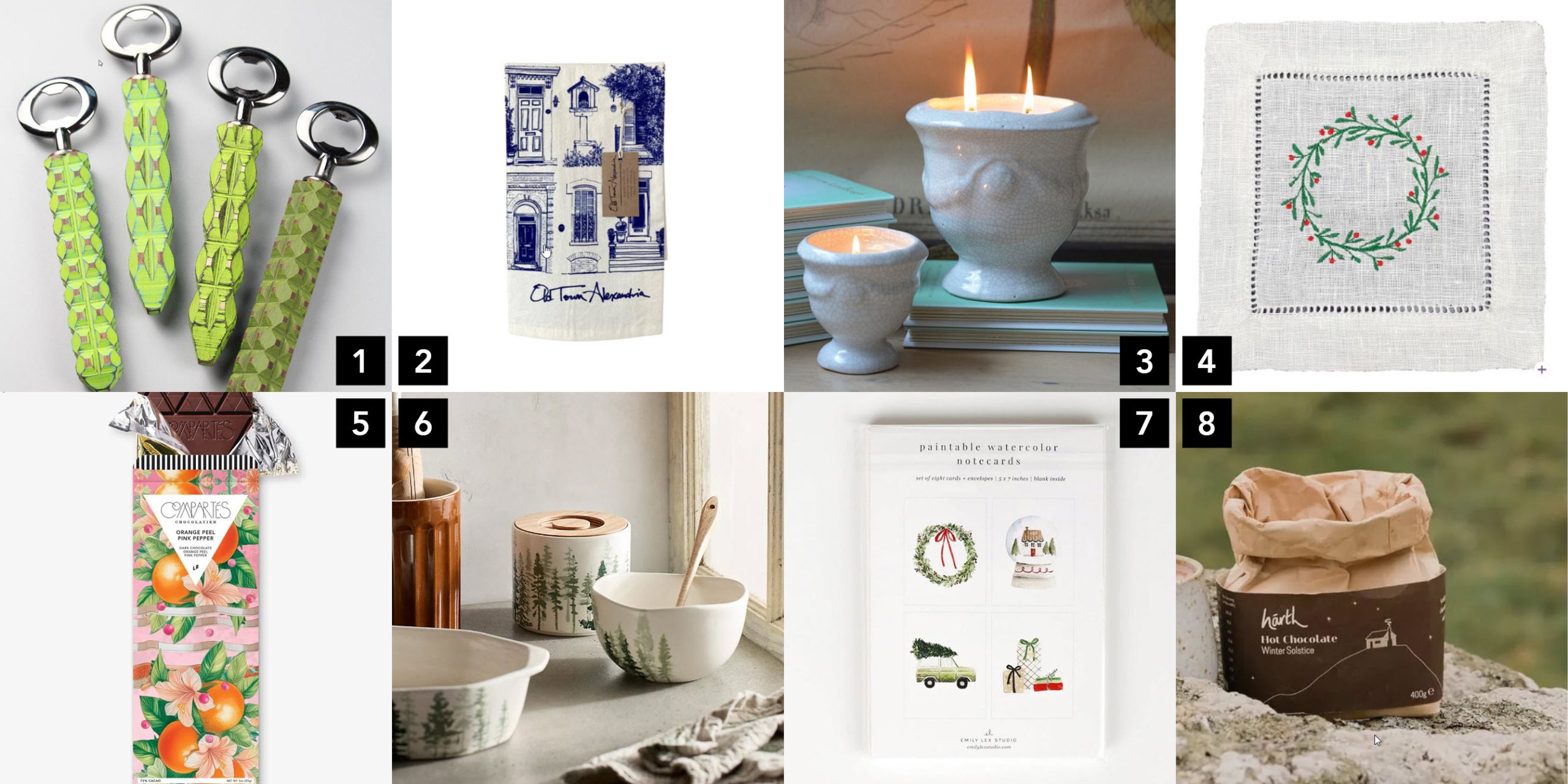

No good guest shows up empty-handed, but who says you have to show up to the holiday party with a bottle of wine or tin of cookies? While no one would turn those gifts away, it can also be fun to treat a friend or loved one to something a bit more memorable and outside of the box. Here, we’re sharing 8 unique and affordable hostess gifts that you can purchase locally, whether you’re in the market for something consumable, decorative, or entertaining-related.
These aren’t your average bottle openers! Pair one of these pretties from Shop Made in VA in Old Town with a six-pack of their favorite beer for a unique twist on a classic hostess gift.
Most people aren’t buying novelty dish towels for themselves (but they’ll definitely appreciate this beautiful Old Town Alexandra-themed one). Available in both blue and black, this towel from Red Barn Mercantile in Old Town will add personality to their kitchen in no time!
Available in both small and large sizes, these candles from Crème de la Crème in Old Town are a crowd-pleaser. Best of all, the vessel is chic enough to repurpose when empty—your recipient can use it to stash pens, makeup brushes, and more.
While in Georgetown, pop over to gift shop A Mano to snag some of these festive cocktail napkins that come as a set of four. Your host will be thrilled to display these all holiday season long.
If you’re looking to pick up something consumable, you can’t go wrong with a couple of these special chocolate bars, available at Salt & Sundry in Union Market. The wrapping is practically too pretty to remove.
Pop by the Terrain store in Bethesda (Terrain is one of Anthropologie’s sister brands, if you didn’t know) and pick up a gorgeous evergreen serving bowl like this one. Since the design isn’t too Christmas-like, your host can enjoy using it all winter long.
7. Christmas Cheer Paintable Notecards by Emily Lex Studio – $18
Vintage lovers will delight in wldwst, which is located in Leesburg and boasts plenty of stocking stuffers and more substantial gifts alike. In the market for a gift for the creative host in your life? Pick up a pack of these paintable notecards, which they can then send out to friends and family members to enjoy—it’s truly the gift that keeps on giving!
8. Swiss Style Drinking Chocolate – $18
No one can resist a rich cup of cocoa this time of year. Present Swiss Style Drinking Chocolate from Federal & Black in Middleburg to your host in lieu of something alcoholic. They can share with the whole family while curled up by the fire.

Sarah Lyon is a New York City-based freelance writer, originally from Bethesda, MD. She contributes to a number of national design and lifestyle publications like Architectural Digest, Apartment Therapy, MyDomaine, the Washington Post, and more. Sarah also works with designers to help them style spaces for photo shoots. Find more shelfies on her Instagram page, @sarahlyon9
Don’t miss a post! Get the latest local guides and neighborhood news straight to your inbox!
Essential Items to Include in Your Guest Room
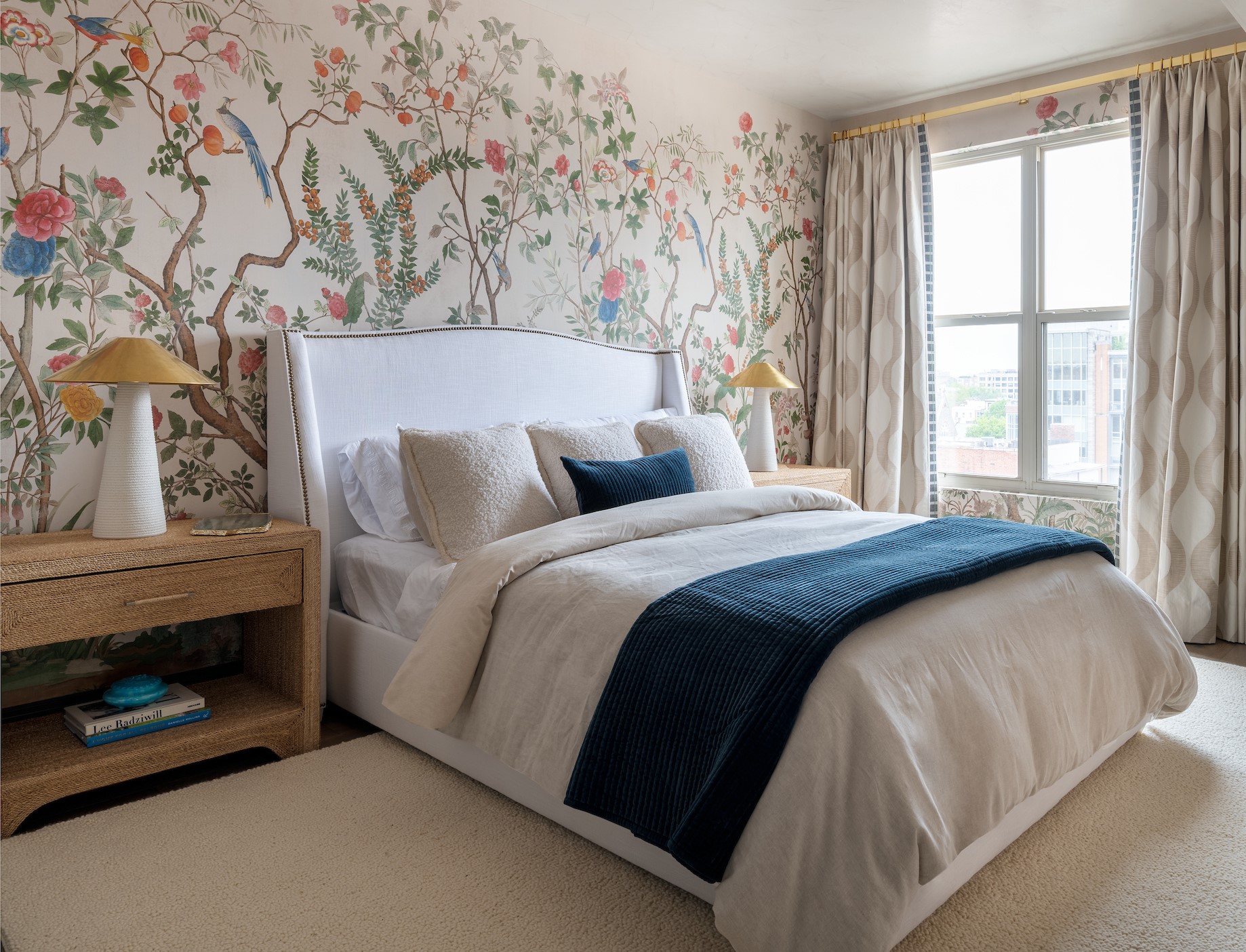
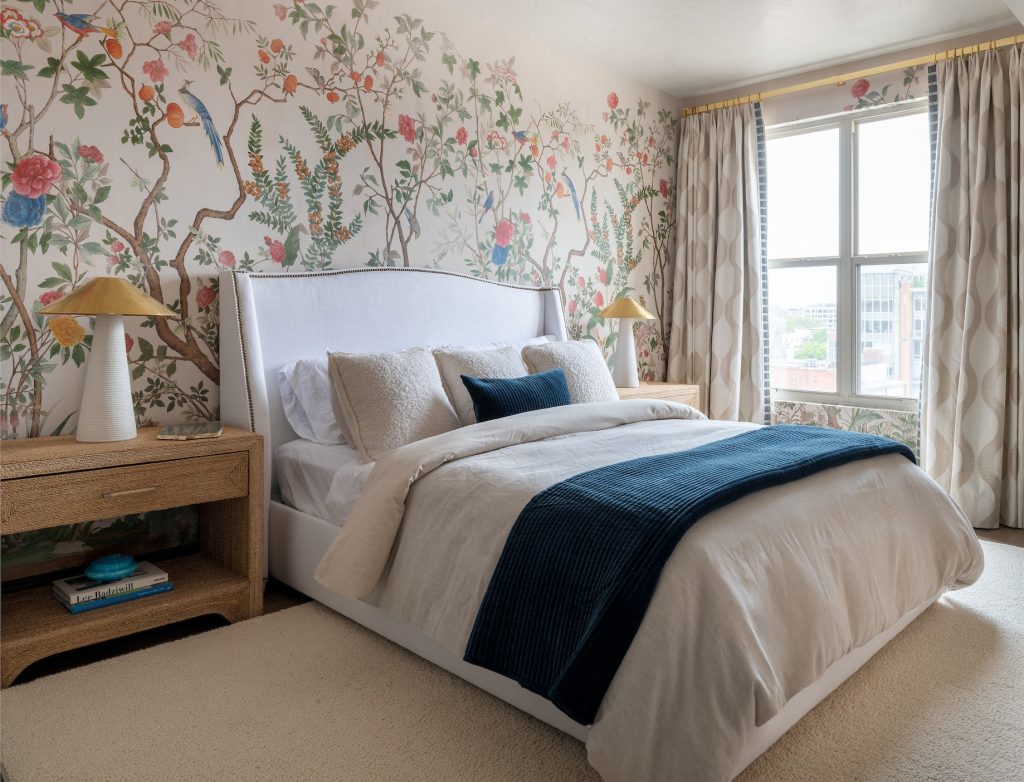
Anthony Wilder Design/Build – Wilderworks bedroom designed by Sydney Levy, photo by John Cole
Holiday guests will be knocking on your front door before you know it! To ensure that your guest room is well-equipped for the season, you’ll want to take some time in the coming weeks to make it as cozy and welcoming as possible using these tips from DMV designers.
Incorporate plush touches
Make your at-home guest room feel like a fancy getaway by weaving in soft accents. “We like to design guest bedrooms that feel like a hotel with plush and luxurious bed linens, soft rugs, and warm tones,” says Sydney Levy, a designer with Anthony Wilder Design/Build.
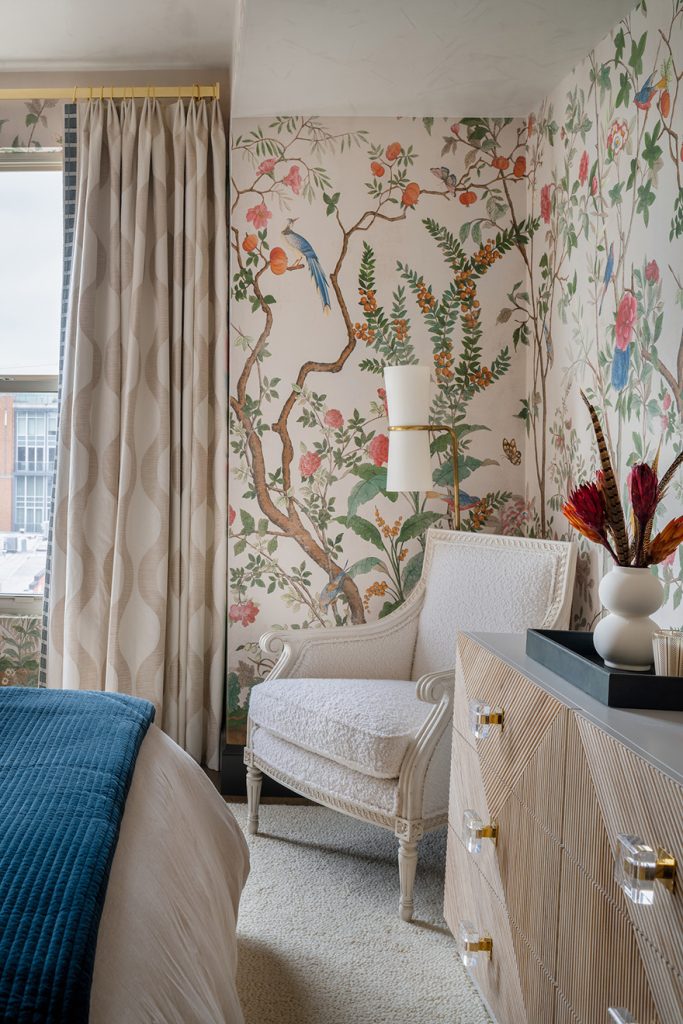
Anthony Wilder Design/Build – Wilderworks bedroom designed by Sydney Levy, photo by John Cole
Treat your visitors to some small items
Take your guest’s experience to the next level by treating them to a small basket of essentials. “I recommend having a beautiful box filled with snacks, mints, small water bottles and sparkling water,” says Sallie Lord, the founder of GreyHunt Interiors. “It will look stunning on a dresser or desk and also lets your guest know you care about how they feel during their stay.”
Other nice touches include a magazine (set out a regional one to get guests into the hometown spirit), a small stack of books, and of course, fresh flowers.
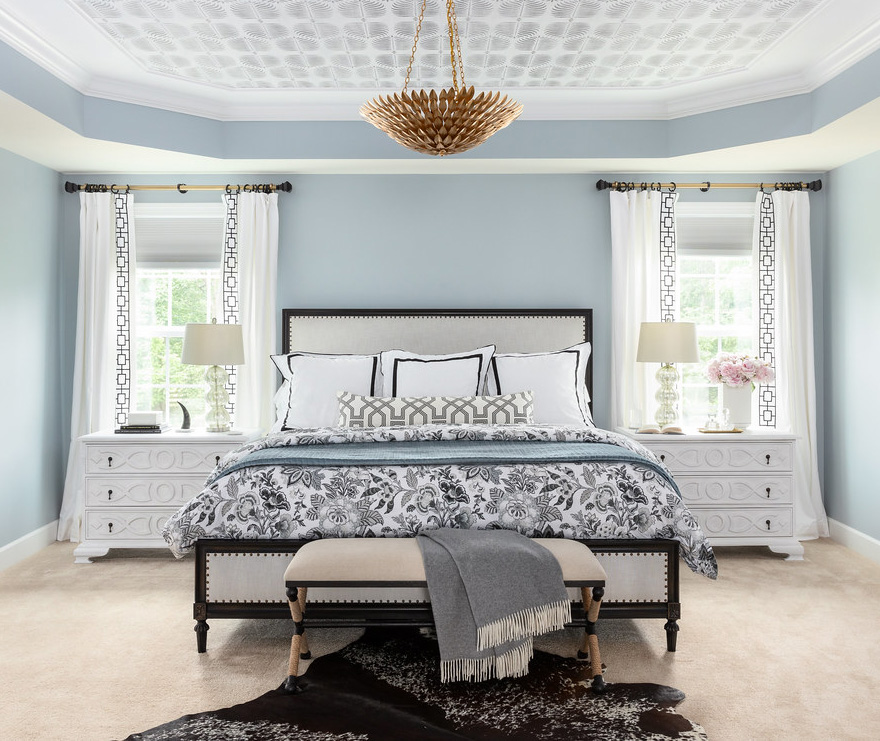
Design by GreyHunt Interiors, photo by Stacy Zarin Goldberg
Supply plenty of towels
When in doubt, opt for more towels rather than less in the guest room. Lord recommends setting out extra clean, fluffy towels as well as a robe, if possible.
Write down the wifi password
Most people will prefer to log onto your home’s wifi rather than burning through data on their phone, and those who do need to sneak a few emails on their laptop will also want access to your login info. Write it down and place it on the bedside table so that it’s easy to reference at all times.
Hide personal effects
If you use your guest room as an office or home gym when you don’t have visitors, make sure to tuck away your file folders and hand weights to create a serene space for guests to unwind. No one wants to be reminded of their to-do list or workout regimen while trying to relax during the holidays!

Sarah Lyon is a New York City-based freelance writer, originally from Bethesda, MD. She contributes to a number of national design and lifestyle publications like Architectural Digest, Apartment Therapy, MyDomaine, the Washington Post, and more. Sarah also works with designers to help them style spaces for photo shoots. Find more shelfies on her Instagram page, @sarahlyon9
Don’t miss a post! Get the latest local guides and neighborhood news straight to your inbox!
Curtain Calls: The Five Best Window Treatment Trends for 2025

This week’s article is giving us inspiration on current window curtain trends by our partners at The Scout Guide.
Thoughtful window dressings can elevate a room, provide proper privacy, and even affect your heating and cooling bills. Whether your motives are leaning in a decorative direction or steadfastly functional, read on for the window treatment trends you’ll find in the most beautiful homes right now. To find a window treatment expert near you, consult The Scout Guide Directory.
1. Create cozy cafe vibes
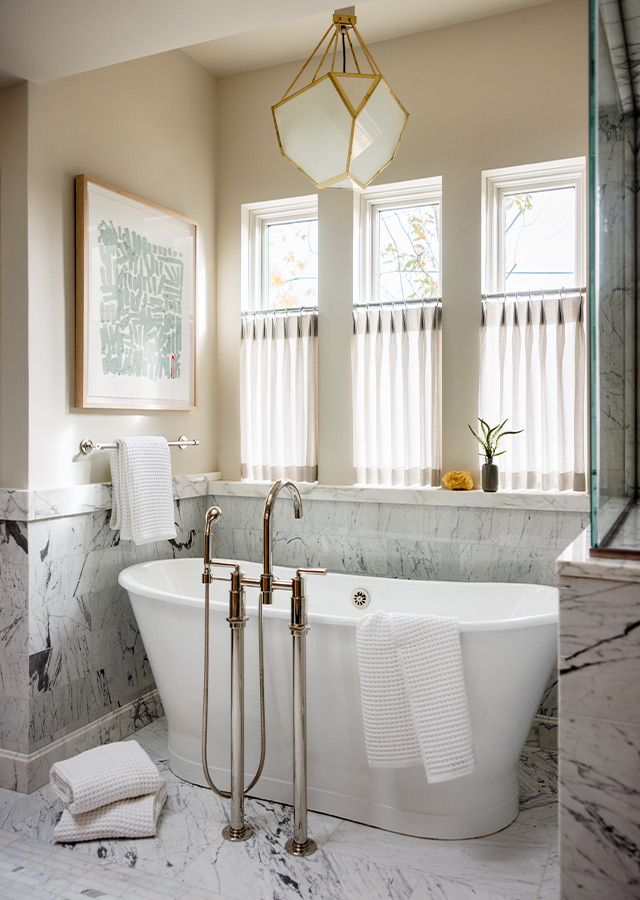
Interior design by Emily Tucker Design. Window treatments by Blinds Couture. Photography by David Lauer.
Cafe curtains are currently all the rage, confirms Jessica Work, CEO of Blinds Couture in Westminster, Colorado. Originating in Austria, and first used in cafes, bistros, and coffee shops, these petite draperies cover only the bottom half of windows, resulting in an ideal combination of privacy while still allowing sunlight to filter in. If you’re interested in trying out this charming curtain style, Work notes this window treatment trend is best suited for kitchens and bathrooms.
2. Dare to be bold
While we love a neutral interior as much as the next person, sometimes a daring design selection is what’s needed to take your home’s design to the next level. From adventurous prints and patterns to cheeky bursts of color, Cade Smith, owner of The Curtain Call in Nashville, Tennessee, explains an audacious window treatment can serve to illuminate a room beyond well-placed lighting. “When you add a vibrant trim to a simple linen shade or curtain or opt for a bold pattern printed on a flaxen woven shade, these touches become the focal point in an otherwise neutral room creating a fabulous space,” Smith says.
3. Lean into layers
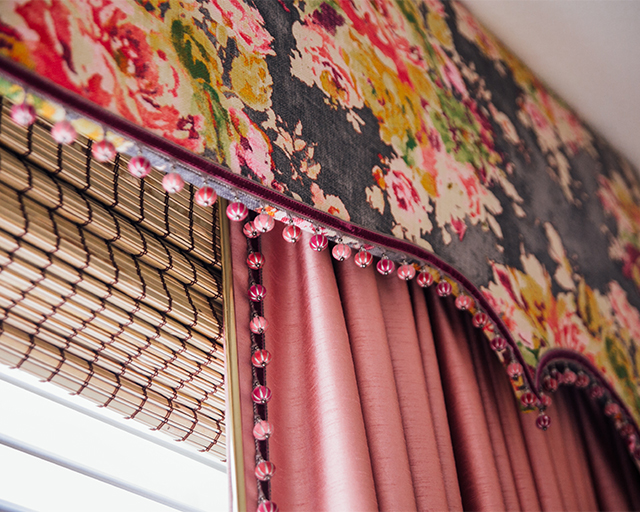
Window treatments by Blinds Couture. Photography courtesy of Blinds Couture.
When you’re seeking a cozy feel in your space, Work advises using a woven wood blind with either decor draperies or functional draperies layered on top. “Bringing in a natural element while layering it with a soft fabric is a harmonious way to treat an opening,” she explains. This window treatment trend is a great option for bedrooms, as it provides an unparalleled degree of privacy, and an instant darkening effect when both coverings are closed.
4. Go for natural textures
“Organic materials and textures have long been a part of interior design, but the tolerance for the fluidity of natural fibers has significantly increased,” Smith says. This window treatment trend turns away from formal draperies with perfect pleats and overly precise hems in favor of an organic design aesthetic that prioritizes materials that convey warmth and ease. Luxe linens, airy cottons, and texture from grasscloth, jute, bamboo, and wood are all wonderful ways to incorporate this trending fiber-forward look.
5. Make it match

Window treatments by Blinds Couture. Photography courtesy of Blinds Couture.
Coordinating your wallcoverings to your fabric window treatment can pay dividends if you’re willing to take the plunge. While this is a daring design decision, Work notes when executed correctly it can instantly elevate any room. Because proper pattern matching can be difficult to achieve, enlisting an interior designer or window treatment expert is advised.
Take a look at our website for all of our listings available throughout Washington, D.C., Maryland, and Virginia.
Don’t miss a post! Get the latest local guides and neighborhood news straight to your inbox!
Designer Tips for Decorating a Front Porch for Fall
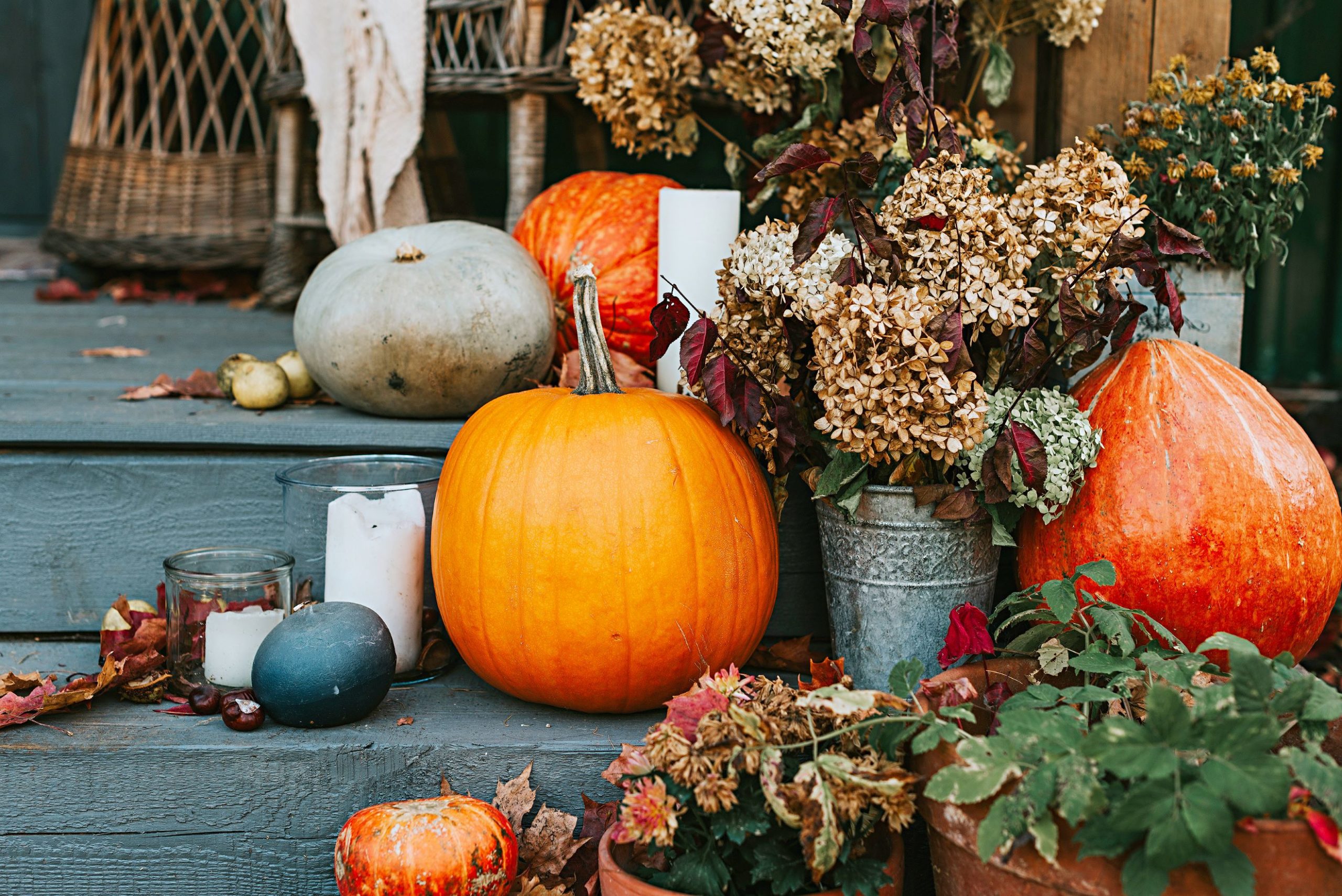

Fall is here, and what better way to welcome the change of weather than by decorating your front porch? We spoke with five area designers who shared their tips for creating a setup that’s seasonal and stylish.
Go Natural
Skip the plastic decorations and outfit your porch with what Ann Gottlieb refers to as “authentic objects”: pumpkins, branches, colorful leaves, and more. That said, you can feel free to get a bit spooky at the same time once you’ve assembled your natural decor. The Fairfax-based founder of Ann Gottlieb Design adds, “I like to incorporate a Halloween element with some noise that turns on as people approach that front porch for that surprise and delight moment.”
Layer Your Decor
When styling your front porch, be sure to layer your decor, instructs Rose Ramseur, the founder of Primrose Interior Design in Fairfax. Layering can take a few different forms, she explains, stating, “If you have a large outdoor rug, you can add a smaller sisal on top.” Mix in objects of various heights, too. “Add taller items in the back and then smaller items in the front,” Ramseur says. “This can mean stacking flower pots on top of an upside-down flower pot or decorative wooden box to add height and then adding smaller decor items like colorful gourds directly on the porch or step.” Finally, layer the colors that you use. “Punch up neutrals like greenery with colorful flowers (mums are always a good choice this time of year) or gourds (real or faux),” the designer says. What makes a successfully styled front porch is a variety in heights, textures, and colors.”
Think Beyond Orange
By no means do you have to stick to traditional orange pumpkins when decorating your front porch for fall. “This year I’ve been gravitating towards greens and purples for interiors and so I am translating that palette into my fall decor,” says Corinne Back, the founder of Corinne Victoria Design in Alexandria. “Start with a bounty of pumpkins, gourds, and filled urns leading up the porch steps: Think black urns filled with purple and white mums, flowering kale and cabbage, fall laurel leaf with berries, and layering in white pumpkins and green gourds.”
Other shades that are perfect for a fall porch include beige, taupe, and cream, as well as deep reds, mustard yellows, and copper accents, adds Maria Loveless, the founder of The L&L Design Team in Manassas.
Think Beyond the Steps
Once you’ve tackled the front steps, keep the decor going! “I love the idea of wrapping dried corn stalks up porch columns to then draw your eye up to the house,” Back adds. “It’s a fun take on classic fall decor that can translate from Halloween to Thanksgiving beautifully.”
Get Cozy
Don’t forget to finish off your porch with cozy touches that will make spending time out front extra relaxing. Blankets, plaid pillows, and lanterns or string lights are some of Potomac designer Elana Mendelson’s favorite touches to include.

Sarah Lyon is a New York City-based freelance writer, originally from Bethesda, MD. She contributes to a number of national design and lifestyle publications like Architectural Digest, Apartment Therapy, MyDomaine, the Washington Post, and more. Sarah also works with designers to help them style spaces for photo shoots. Find more shelfies on her Instagram page, @sarahlyon9
Don’t miss a post! Get the latest local guides and neighborhood news straight to your inbox!
Plant Bulbs Now for Spring Blooms
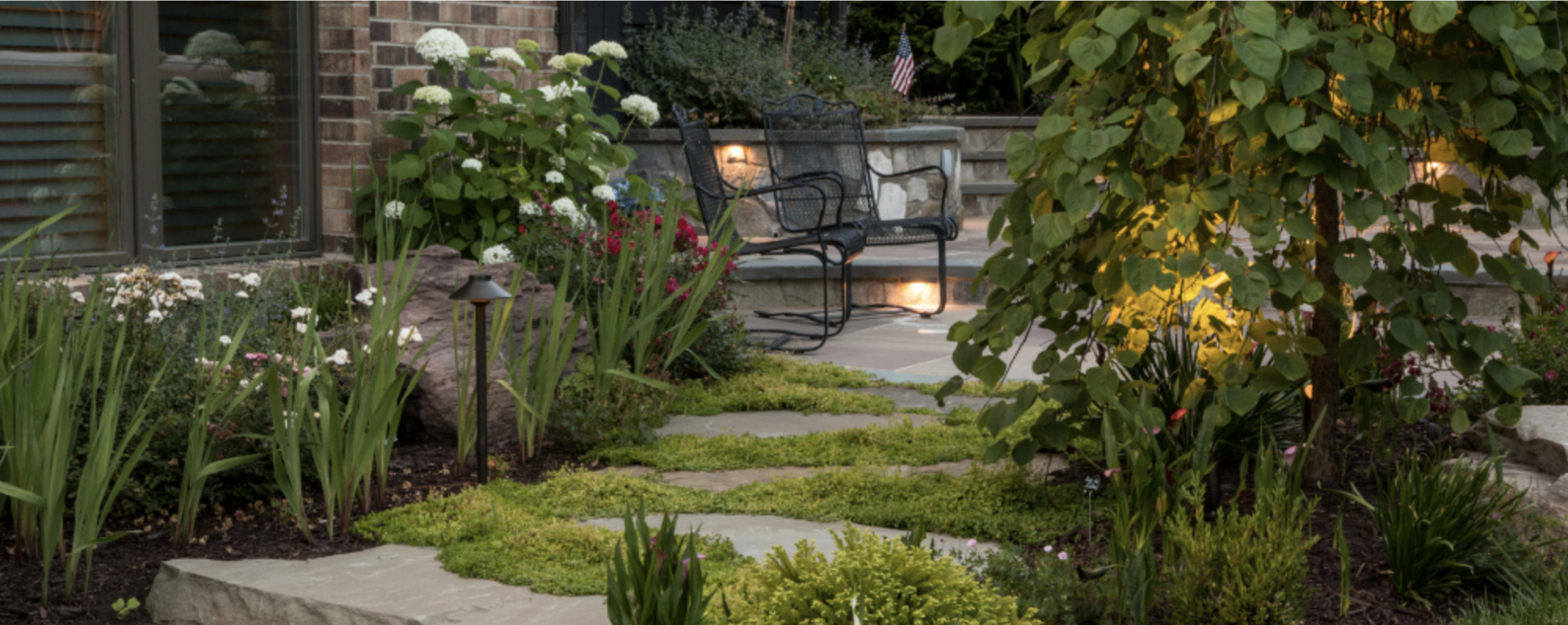
This week’s blog post is provided by Artscapes Living.
Planting a garden that blooms throughout the year takes a little planning, so here’s a little tip for spring blooms: you need to plant bulbs NOW.
One of the most popular and beloved choices for spring gardens is the tulip.
Tulips: A Classic Choice
Tulips are a popular bulb for yards because of their brilliant colors and early blooms.
With their wide range of colors, from soft pastels to bold jewel tones, tulips can be easily incorporated into any garden design.
Beyond their aesthetic appeal, tulips are relatively easy to grow. They thrive in well-drained soil and require minimal maintenance once planted. To ensure they thrive, it’s essential to plant them before the first frost.
Beyond Tulips: A Variety of Options
While tulips are a popular choice, there are countless other bulbs to consider for your spring garden. Explore the beauty of crocus, snowdrops, scilla, and winter aconite for an early spring burst of color. These petite blooms can add a touch of whimsy to your landscape, even emerging from the snow in some regions.
For a mid-spring spectacle, consider planting hyacinths, daffodils, and muscari. Hyacinths offer fragrant blooms in a variety of colors, while daffodils are known for their cheerful yellow flowers and ability to naturalize easily. Muscari, with its grape-like clusters of blue or purple flowers, adds a unique and charming touch to any garden.
And for a late spring spectacle, consider planting alliums, fritillaria, irises, or triteleia. Alliums boast large, globe-shaped flowers in various colors, while fritillaria feature unique, nodding blooms with checkered patterns. Irises, with their elegant flowers and sword-like leaves, add a touch of sophistication to any garden. Triteleia, with its clusters of small, star-shaped flowers, offers a delicate and charming display.
Planning for Summer Blooms
Looking to extend your garden’s beauty into summer? Consider planting annuals like cosmos, zinnias, sunflowers, marigolds, petunias, nasturtiums, morning glories, or ageratum. These vibrant flowers will add color, attract pollinators, and create a stunning summer landscape.
Remember to select bulbs that thrive in your local climate and soil conditions to ensure a successful spring and summer garden.
Now that you have a head start on your bulb planting, are you ready to take your garden to the next level? Contact me today to schedule a free 15-minute phone consultation. We’ll discuss your vision and create a personalized plan to transform your outdoor space into a blooming paradise.

Pragya Mishra is the Founder and Principal of Artscapes, LLC, a Northern Virginia-based landscape architecture firm that specializes in designing outdoor transformations that bring you joy. With 22 years of professional experience, she works closely with each client and her network of top-tier contractors to make each project vision a reality. Follow Artscapes on Instagram @artscapes_living and see examples of past projects on her website, www.artscapesliving.com.
Take a look at our website for all of our listings available throughout Washington, D.C., Maryland, and Virginia.
Don’t miss a post! Get the latest local guides and neighborhood news straight to your inbox!
3 Area Designers Share The Most Common Kitchen Requests They Receive
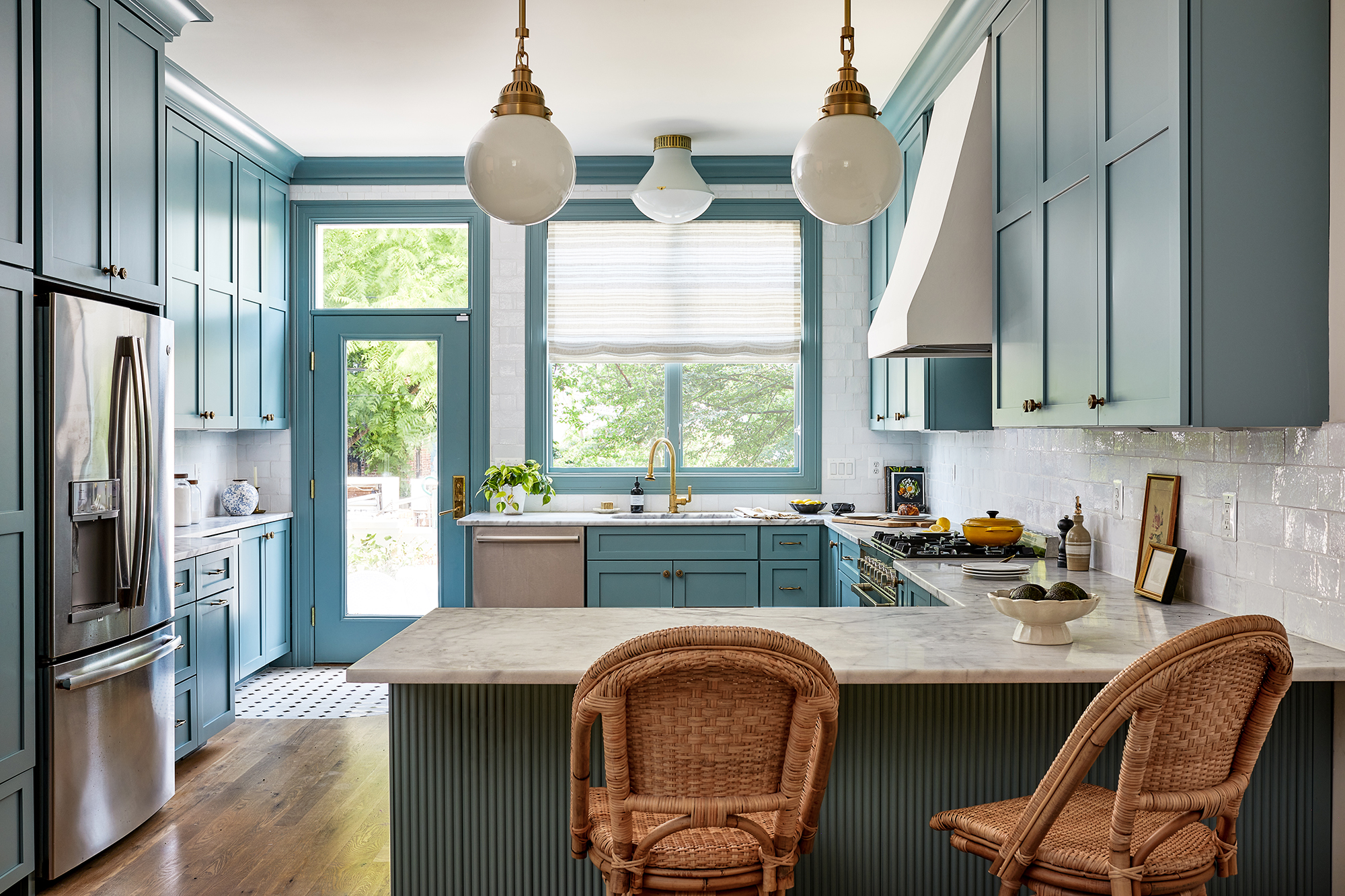
Kitchen trends come and go—for example, a few years back, all-white kitchens were all the rage, while nowadays, people are enjoying experimenting with bolder colored cabinetry and finishes. When locals dial up an interior designer to get some help revamping their cooking space, what exactly are they asking for? We spoke with three designers—one in Maryland, another in DC, and the third in Virginia—to learn what’s been in demand.
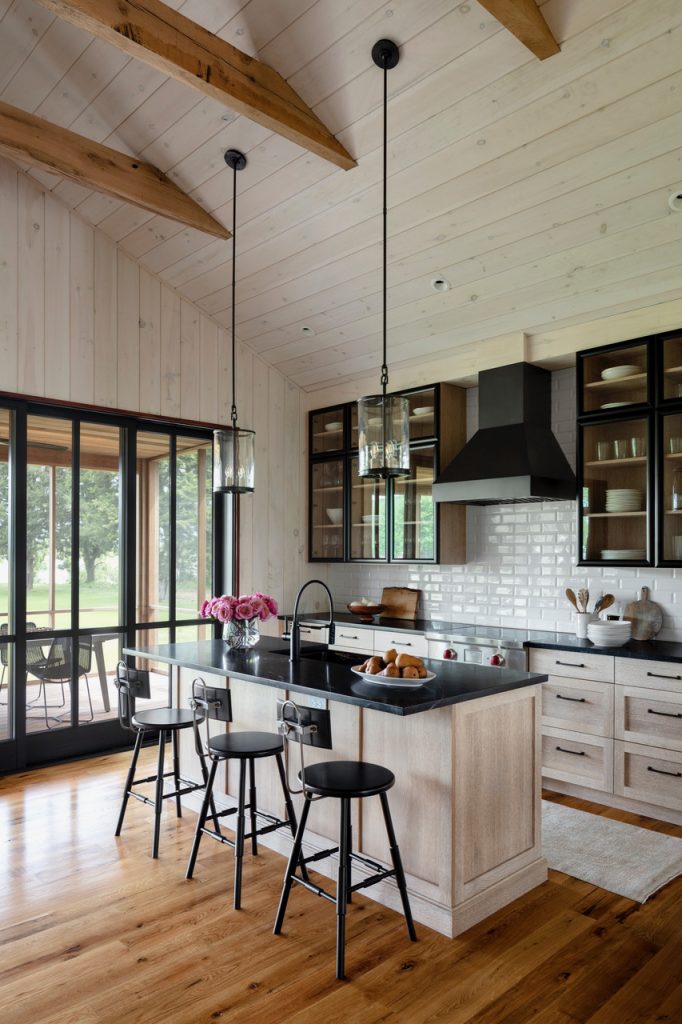
Design by Laura Hodges Studio. Photography by Jennifer Hughes.
Cabinet Upgrades:
Many of Sara Swabb’s clients turn to her for assistance with cosmetic updates including cabinetry revamps. Oftentimes, they are eager to paint kitchen cabinets a new color and will work with Swabb to identify a shade and professional painter who can get the job done. Clients are also eager to update their kitchen cabinet hardware, says Swabb, the founder of Storie Collective in Washington, DC.
Catonsville-based Laura Hodges is also a pro at making cabinet updates. “In a new home, our clients will often want to change the cabinetry, especially if the layout and functionality aren’t a good fit for their family,” explains the founder of Laura Hodges Studio. She will sometimes also retrofit existing cabinets with custom wooden inserts to improve their functionality.
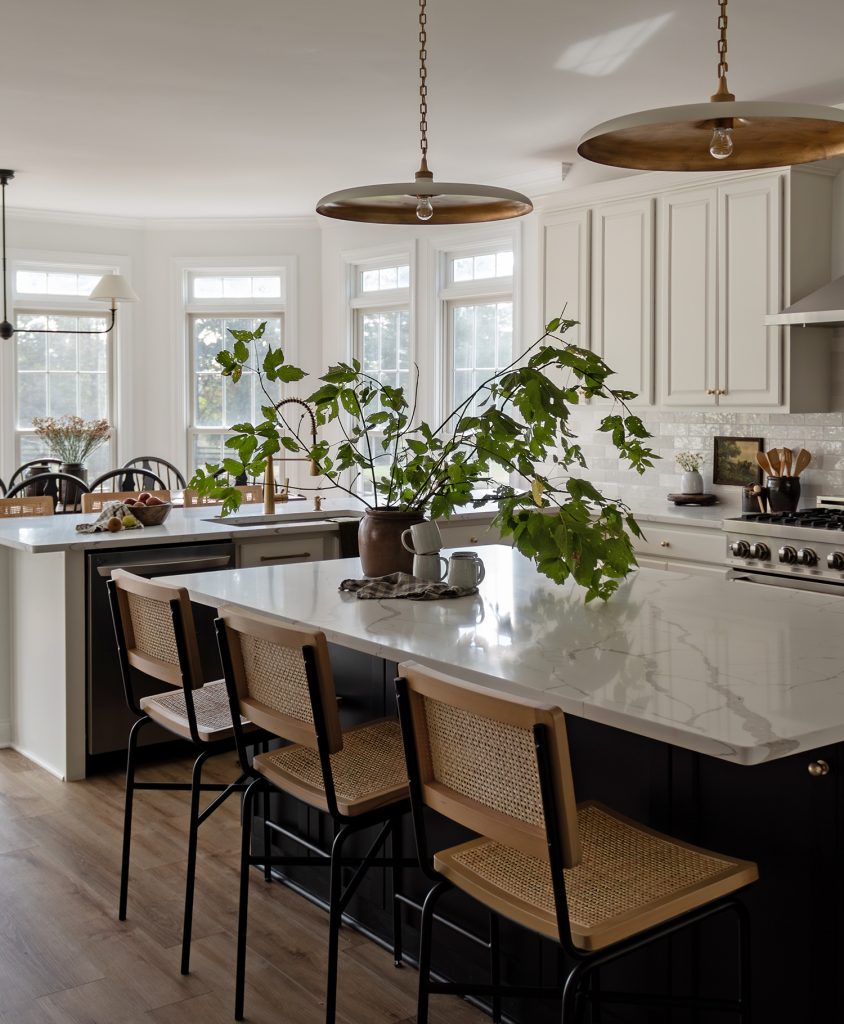
Design and photography by Kevin Billings.
Warming up the Space:
Kevin Billings, the founder of Dexter & Plaid in Leesburg, works with many clients who crave brighter, warmer cooking spaces. “Many of my clients do not want the stark white kitchen and prefer something that feels warmer, more inviting, and just less sterile,” he says. Sometimes, this means updating the cabinetry, but it may also involve weaving organic elements into the kitchen, he shares. “The easiest way is through wood elements, like in shelving or beams,” Dexter says. “Just adding these natural materials can really tone down any sterile or cold feeling a kitchen may have.” Billings will also bring unlacquered brass, which will patina nicely over time, into the mix with a new faucet or type of cabinet hardware.
Lighting Changes:
Swabb also works with clients who crave new kitchen lighting. Projects may include “swapping out pendants for a fresh selection or transitioning from recessed lights to small flush mounts,” the designer says.

Sarah Lyon is a New York City-based freelance writer, originally from Bethesda, MD. She contributes to a number of national design and lifestyle publications like Architectural Digest, Apartment Therapy, MyDomaine, the Washington Post, and more. Sarah also works with designers to help them style spaces for photo shoots. Find more shelfies on her Instagram page, @sarahlyon9
Don’t miss a post! Get the latest local guides and neighborhood news straight to your inbox!
Design Report: The Hottest Interior Gray Paint Color
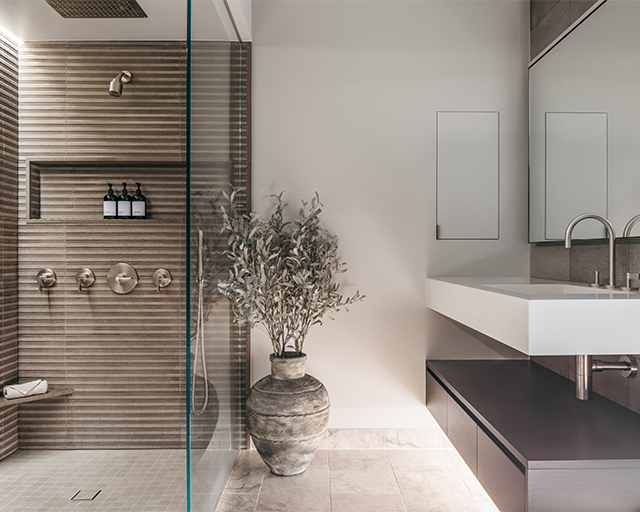
This week our partners at The Scout Guide give us inspiration on trendy gray paint colors for your home.
For most of this century, gray paint has reigned supreme as the neutral interior color of choice. Embraced for its timeless and versatile nature, from warm organic greiges to darker, steely tones, gray continues to check the box for many design profiles. Here, we’ve tapped two Scouted interior experts to give us the inside scoop on the gray paint colors you should consider when embarking on your next interiors refresh. To find a Scouted interior designer near you, consult The Scout Guide Directory.
1. Anonymous, Sherwin Williams
Interior design by Krystal Dawn Design. Photography by Kimberly Meadowlark.
”Opting for a medium-to-dark gray paint infuses a space with timeless sophistication. This tone exemplifies versatility and creates a refined and elegant ambiance. By color-drenching this home office space with a uniform shade across the ceiling, walls, and trim, a cohesive and subtly moody atmosphere is achieved that enhances the room’s depth and sophistication.“– Krystal Matthews, owner and principal designer of Krystal Dawn Design in Baton Rouge, Louisiana
2. Conservative Gray and Thunder Gray, Sherwin Williams
Interior design by Krystal Dawn Design. Photography by Kimberly Meadowlark.
“Combining shades of gray that complement one another is an excellent way to add warmth, depth, and visual interest to a space. Warm gray tones bring a sense of comfort and enhance the overall atmosphere. In this primary bedroom, Conservative Gray on the walls, Thunder Gray on the ceiling, blend seamlessly to create an organic look.” – Matthews
3. Trout Gray, Benjamin Moore
Interior design by Edit Design Creative. Photography by Rosemary J Photography.
“Trout Gray is an easy choice for us when we are looking for a moody, sophisticated gray. We used this charcoal colored hue in our client’s library, a space where they can both relax after a long day as well as entertain, so we wanted to choose a gray that was multi-purpose. Trout Gray is one of our favorites to create some drama while still keeping the room neutral.” – Erika Peck, principal at Edit Design Creative in Chicago, Illinois
4. Useful Gray, Sherwin Williams
Interior design by Krystal Dawn Design. Photography by Haylei Smith.
“The walls of this space are painted with Useful Gray, a color that features more beige undertones, as opposed to the blue. A warm gray like this one offers a cohesive, inviting look, whereas steely grays can clash with warm tones, making an interior appear cold.” – Matthews
5. Cumulus Cloud, Benjamin Moore
Interior design by Edit Design Creative. Photography by Margaret Rajic Photography.
“The perfect gray for anyone looking for a neutral tone, Cumulus Cloud is a well-rounded gray that is quickly becoming our favorite. This isn’t a gray that goes red, blue, or green, but rather has a slight hint of warmth, which gives it softness. Beautiful in rooms with a lot of natural light, it allows for the subtle color to be the background to your interior. Alternatively for our client’s house, we used this color in the primary bathroom with little natural light and we found it really brightened up the space against the dark tile. Adding this contrast to the room gave the bathroom a spa-like feel.” – Nicole Parke, principal at Edit Design Creative in Chicago, Illinois
Krystal Dawn Design appears in The Scout Guide Baton Rouge. Edit Design Creative appears in The Scout Guide Chicago.
Take a look at our website for all of our listings available throughout Washington, D.C., Maryland, and Virginia.
Don’t miss a post! Get the latest local guides and neighborhood news straight to your inbox!
Designing Your Dream Patio
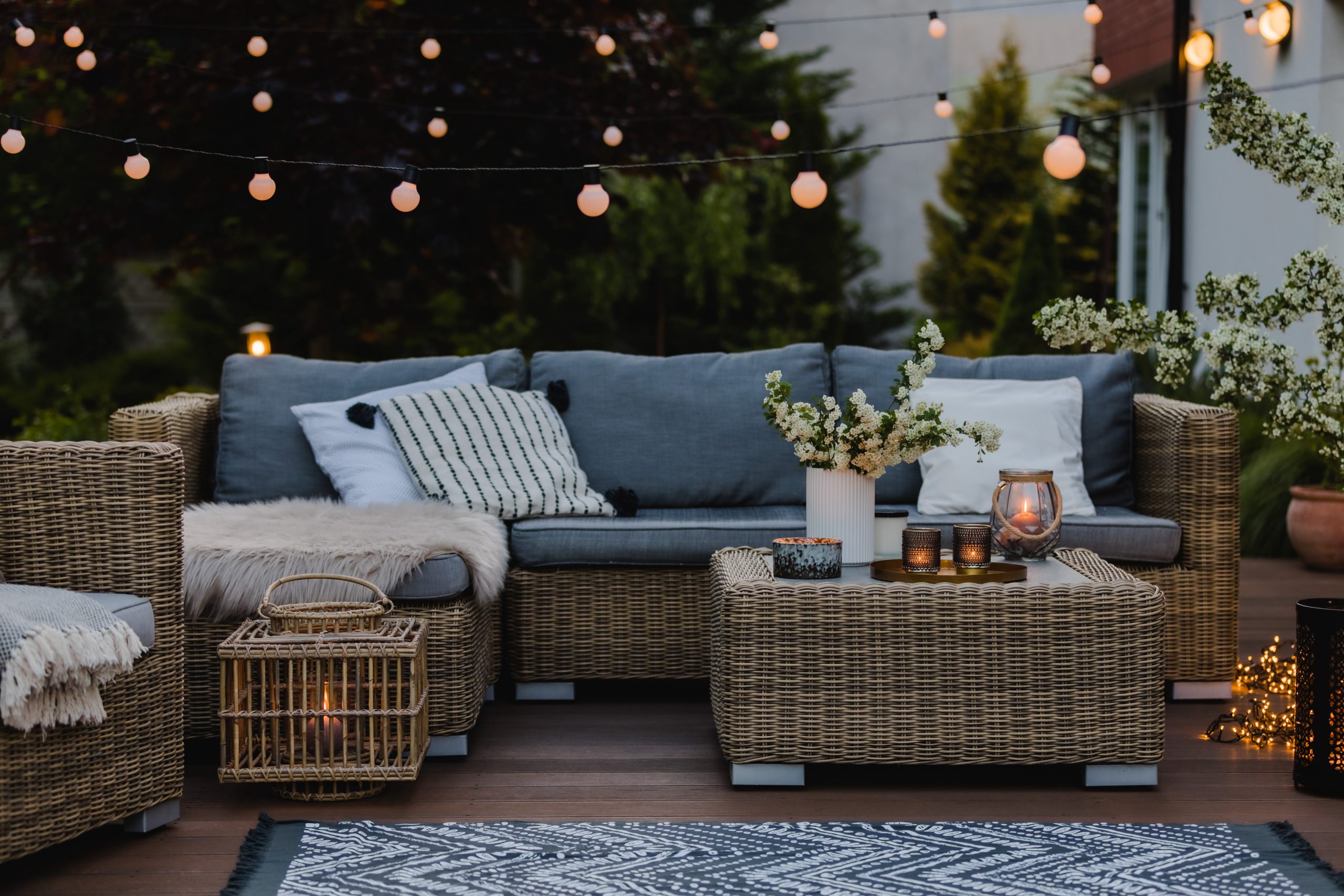

This week’s blog post is provided by Artscapes Living, giving us inspiration on how to design your dream patio.
A patio is more than just a concrete slab; it’s an extension of your living space where you can relax, entertain, and connect with nature. Installing a patio requires careful design upfront, so here are six tips to help you transform your outdoor area!
1. Choose Suitable Materials
The material you choose sets the tone for your patio. From classic brick and natural stone to low-maintenance concrete and composite decking, the choice of materials is crucial. Consider your budget, desired aesthetic, and local climate when selecting the perfect patio surface. Don’t forget to factor in the maintenance and upkeep of the materials you choose.
2. Design Seating Areas
Invest in high-quality outdoor furniture that matches your patio’s style and offers optimal comfort. Consider a mix of seating options, such as sofas, lounge chairs, and dining sets, to accommodate various activities. Think about how you’ll use the space, and plan for seating arrangements accordingly. For example, if you tend to host a large group of people, choose items that offer many seating options but are also easy to rearrange. On the other hand, if you want a quiet spot to drink your morning coffee or enjoy a good book, opt for more comfortable seats.
3. Incorporate Shade
Whether it’s a pergola, umbrella, or mature trees, shade allows you to enjoy your patio during sunny and rainy days. There are hundreds of options, so choose one that fits into your design but also provides you the benefits you need. For example, some solutions are temporary and enable you to move them as needed while others are more permanent structures that require less set-up time. Some shades offer water resistance and UV protection, and others can add misters or outdoor heaters to enjoy the patio in less-than-ideal temperatures.
4. Add a Touch of Green
A touch of green can transform your patio from a simple outdoor space into a vibrant oasis. Consider planters, hanging baskets, or vertical gardens to add color and life to your outdoor space. Incorporating greenery can also provide more privacy, enhance aesthetics, reduce stress, improve air quality, and increase your property value.
5. Add Water Features
While this option is not a must, many of my clients ask for a water feature as part of their patio design. The soothing sound of water can instantly transform your patio into a tranquil retreat. Explore fountains, ponds, or even small waterfalls to create a focal point and enhance the ambiance.
6. Incorporate Outdoor Lighting
Some of your best patio moments may come at night, which is why outdoor lighting is so important to outdoor design. Consider string lights, lanterns, or spotlights to create a stunning, warm, and inviting nighttime ambiance. I opt for uplighting on stairs and key design features for a more elegant look, as opposed to runway lights or floodlights.

Pragya Mishra is the Founder and Principal of Artscapes, LLC, a Northern Virginia-based landscape architecture firm that specializes in designing outdoor transformations that bring you joy. With 22 years of professional experience, she works closely with each client and her network of top-tier contractors to make each project vision a reality. Follow Artscapes on Instagram @artscapes_living and see examples of past projects on her website, www.artscapesliving.com.
Take a look at our website for all of our listings available throughout Washington, D.C., Maryland, and Virginia.
Don’t miss a post! Get the latest local guides and neighborhood news straight to your inbox!
The Biggest Landscaping Trends You Can Expect to See This Fall
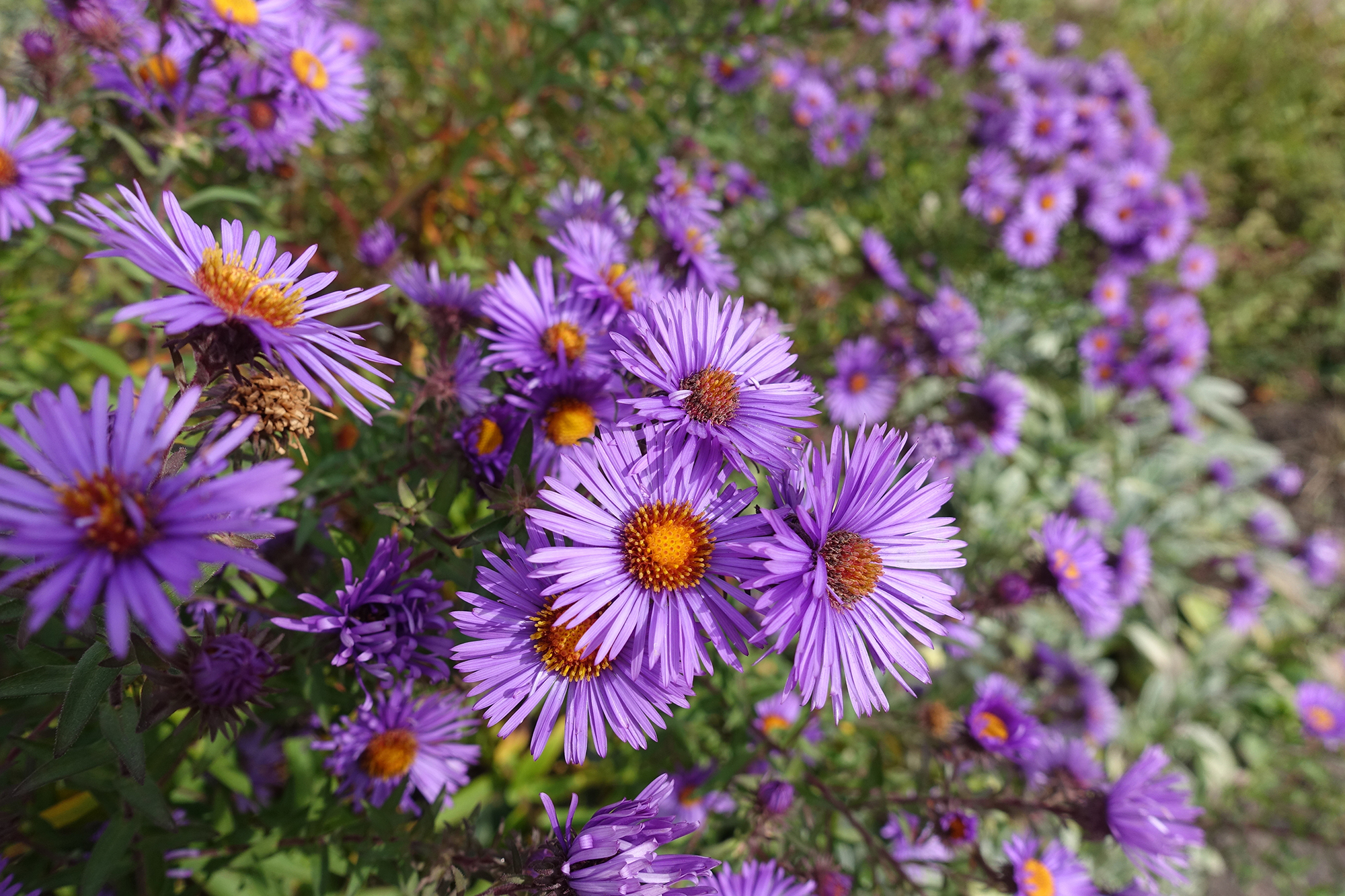
It’s never too early to start thinking ahead to your fall landscaping. Though it’s only the middle of August, autumn will be here before we know it! To find out what’s trending this season in the landscape world, we spoke with Jordan Clough, associate principal at Richardson & Associates Landscape Architecture in Washington, DC, who shares his insights below.
Traditional Fall-Like Hues
Bring on the festive fall hues. “Fall is a time of bright colors, lean into it with plantings that highlight the season,” Clough says. Don’t stop with just maple trees, get creative when it comes to perennials, too, he suggests. Some of his favorite picks for the season include Amsonia, New England Aster (“a high contrast of gold foliage and purple flowers, and it can be seen in person at the National Arboretum if you are curious”), Witch Alder, Autumn Fern, and Stonecrop Sedum.
Maximalist Design
If you love decorating your indoor space to the max, you’re in luck, because the maximalist aesthetic is having a moment outdoors, too, Clough says. “Add some patterns and color accents with outdoor rugs, outdoor pillows, or a boldly-patterned throw blanket near the fire pit or outdoor fireplace,” he suggests. “With the days getting shorter, lighting will also become important, and with this trend you can accessorize with lanterns or candelabras.”

Photo courtesy of Richardson & Associates Landscape Architecture
Cozy Fire Pits
Make the most of cool nights outdoors with a fire pit or related setup. “I particularly like ‘fire tables,’ which usually have a deep rim or ledge for setting drinks, and can double as a coffee-table type of furnishing when they are not lit,” Clough says. Of course, you’ll want to determine whether you’re seeking a manmade or natural solution in the yard. “When considering a fire feature, gas (natural or propane) offers a clean, easy-start, and practically zero maintenance, but in my opinion nothing beats the smells and sounds of a wood fire,” Clough adds. And, he notes, don’t forget about wood storage—a rack or metal ring, for example, is helpful to store and protect wood.
Off-Season Florals
Coneflower, False Indigo, Black-eyed-Susans, Bee Balm, and other flowers with dark seed-heads can last throughout cooler months, Clough shares. “These add great interest to the garden through the cold months with their contrast against the snow and light grasses, and giving some height and structure to a garden bed,” he says. “These seed heads also provide essential cover and food for our local birds and wildlife.”

Sarah Lyon is a New York City-based freelance writer, originally from Bethesda, MD. She contributes to a number of national design and lifestyle publications like Architectural Digest, Apartment Therapy, MyDomaine, the Washington Post, and more. Sarah also works with designers to help them style spaces for photo shoots. Find more shelfies on her Instagram page, @sarahlyon9
Visit corcoranmce.com to search listings for sale in Washington, D.C., Maryland, Virginia, and West Virginia.
Don’t miss a post! Get the latest local guides and neighborhood news straight to your inbox!
5 Kitchen Cabinet Color Trends We’re Loving

This week we would like to share an article from our partners at The Scout Guide informing us of trendy kitchen cabinet colors.
Thanks to the sage advice of our Scouted design experts, we’ve uncovered the kitchen cabinet color trends you’ll increasingly find in the most stylish homes. The key to superior storage? Injecting a healthy dose of personality.
1. Get playful with pastels
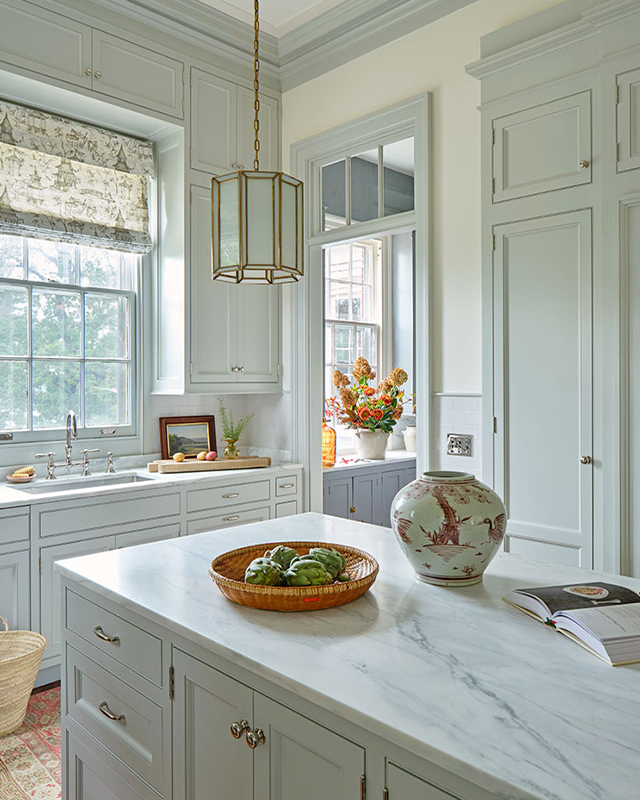
Interior design by Julie Terrell Interior Design; photography by Hector Sanchez.
For those who love a colorful kitchen but are more restrained in their design aesthetic, Julie Terrell, owner of Julie Terrell Interior Design in Birmingham, Alabama, recommends opting for a pretty pastel hue. The main benefits of pastel cabinetry is its ability to add color and charm to a kitchen while keeping the space bright. Ready to try out this trend? Terrell is especially fond of a classic light blue, which pairs well with neutral colors and natural materials.
2. Wood veneers make a comeback
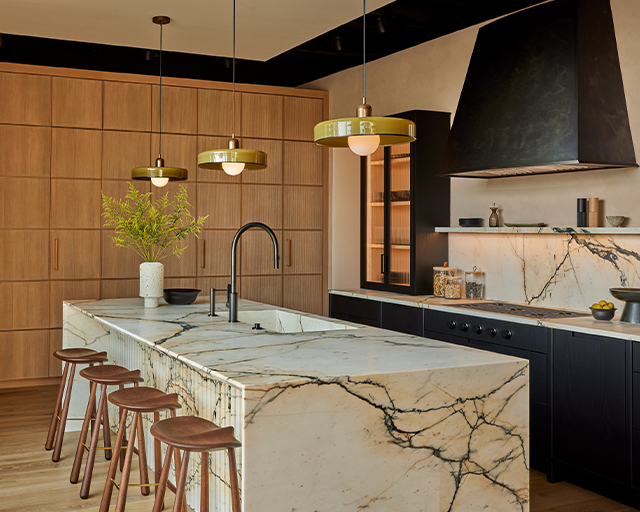
Kitchen cabinetry by Bluebell Fine Cabinetry & Design; photography by Jason Varney; styling by Kristi Hunter.
Everything old is new again and today’s more modern kitchens are featuring rich wood veneers. Peter Cardamone, creative director and partner at Bluebell Fine Cabinetry & Design in Wayne, Pennsylvania, explains that to enhance this sleek, minimalist design approach, incorporate integrated finger grooves as handles. This allows the beautiful wood finish and clean lines to shine without the interruption of hardware.
3. Go bold with color
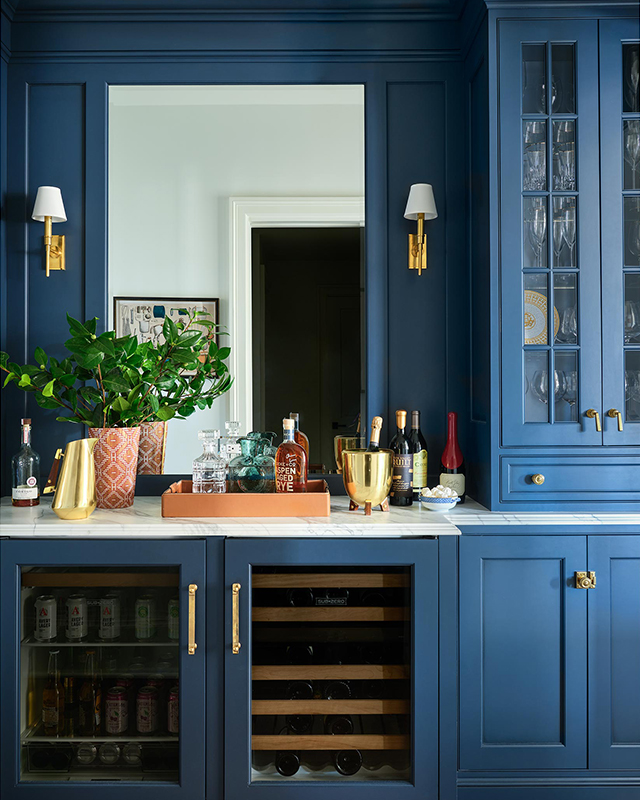
Interior design by Shed & Co; photography by David Patterson; styling by Natalie Warady.
All-white kitchens are a classic that will never go out of style, but Cassy Kicklighter Poole, founder and owner of Shed & Co. in Denver, Colorado, notes that adventurous color choices are becoming a lauded option. “While a neutral palette in a kitchen will always have our hearts, when it comes to cabinetry I am all for a pop of color to achieve an element of drama and whimsy,” she explains.
4. Mix it up
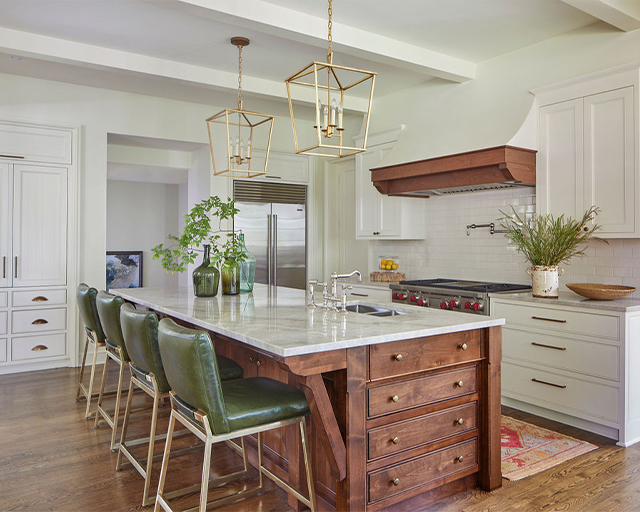
Interior design by Julie Terrell Interior Design; photography by Jean Allsopp.
Easily executed in a multitude of chic combinations, kitchen cabinetry featuring mixed finishes is a surefire way to create a bespoke feeling in the heart of your home. Terrell suggests the classic pairing of white cabinetry and warm natural wood to anyone interested in moving forward with this double dose of design. “When used on the island or base cabinets, natural wood adds visual weight and elegance to a timeless white kitchen,” she says. If you desire a more moody vibe, Cardamone loves the look of light blues, greens, and taupes, such as Farrow and Ball Elephants Breath, mixed with accents of rift white oak and rich walnut.
5. Embrace natural wood

Kitchen cabinetry by Bluebell Fine Cabinetry & Design; photography by Jason Varney; styling by Kristi Hunter.
Rift cut oak cabinets—favored for its captivating linear appearance and color variations—are on the rise thanks to the warmth and natural movement they create in a space. A more traditional option than the wood veneers referenced above, Kicklighter appreciates rift cut oak cabinetry for its ability to seamlessly blend with various design aesthetics, allowing for flexibility in the finishes and accessories, as well as the peace of mind that your kitchen design can morph if your tastes change in the future.
For more expert advice on kitchen design, discover which countertops are hot right now and get inspired by our Kitchen Trend Report.
Don’t miss a post! Get the latest local guides and neighborhood news straight to your inbox!

 Facebook
Facebook
 X
X
 Pinterest
Pinterest
 Copy Link
Copy Link







